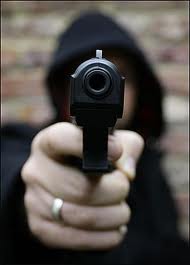Assault With a Deadly Weapon

Penal Code Section 245 States:
“(a) (1) Any person who commits an assault upon the person of another with a deadly weapon or instrument other than a firearm or by any means of force likely to produce great bodily injury shall be punished by imprisonment in the state prison for two, three, or four years, or in a county jail for not exceeding one year, or by a fine not exceeding ten thousand dollars ($10,000), or by both the fine and imprisonment.
(2) Any person who commits an assault upon the person of another with a firearm shall be punished by imprisonment in the state prison for two, three, or four years, or in a county jail for not less than six months and not exceeding one year, or by both a fine not exceeding ten thousand dollars ($10,000) and imprisonment.
(3) Any person who commits an assault upon the person of another with a machinegun, as defined in Section 16880, or an assault weapon, as defined in Section 30510 or 30515, or a .50 BMG rifle, as defined in Section 30530, shall be punished by imprisonment in the state prison for 4, 8, or 12 years.
(b) Any person who commits an assault upon the person of another with a semiautomatic firearm shall be punished by imprisonment in the state prison for three, six, or nine years.
(c) Any person who commits an assault with a deadly weapon or instrument, other than a firearm, or by any means likely to produce great bodily injury upon the person of a peace officer or firefighter, and who knows or reasonably should know that the victim is a peace officer or firefighter engaged in the performance of his or her duties, when the peace officer or firefighter is engaged in the performance of his or her duties, shall be punished by imprisonment in the state prison for three, four, or five years.
(d) (1) Any person who commits an assault with a firearm upon the person of a peace officer or firefighter, and who knows or reasonably should know that the victim is a peace officer or firefighter engaged in the performance of his or her duties, when the peace officer or firefighter is engaged in the performance of his or her duties, shall be punished by imprisonment in the state prison for four, six, or eight years.
(2) Any person who commits an assault upon the person of a peace officer or firefighter with a semiautomatic firearm and who knows or reasonably should know that the victim is a peace officer or firefighter engaged in the performance of his or her duties, when the peace officer or firefighter is engaged in the performance of his or her duties, shall be punished by imprisonment in the state prison for five, seven, or nine years.”
Assault is a crime where the person accused puts the victim in reasonable fear of bodily injury; it is not required that the person charged with this offense actually have physical contact with the victim.
The offense of Assault with a Deadly Weapon occurs when a person points a dangerous weapon or a firearm at another person. In the case of assault with a firearm, even if the gun was not loaded and even if the person holding the gun had no intention of using the gun he or she can still be charged if the victim was in reasonable fear as a result of the person brandishing or pointing the gun at the victim.
Assaults can be charged as misdemeanors or felonies; generally speaking use of a dangerous weapon will cause the matter to be a felony, although there are exceptions are made. Misdemeanor Assaults carry a maximum of 1 year in jail although most people accused of this crime at the misdemeanor level may do little or no jail time if represented by an experienced attorney. Felony Assaults with Deadly Weapons can cause a person to be imprisoned for up to 12 years depending on the weapon used. Assault with a deadly weapon can also be a “strike” offense.
It should be noted that a person can be charged with assault with a deadly weapon even if the ‘weapon’ used is not ordinarily ‘deadly’, such as a chair, or not normally considered a ‘weapon’, such as an automobile.
ASSAULT WITH A DEADLY WEAPON: What the Prosecutor MUST Prove Beyond a Reasonable Doubt
Jury Instruction 875. Assault With Deadly Weapon or Force Likely to Produce Great Bodily Injury
The defendant is charged [in Count ] with assault with (force likely to produce great bodily injury/a deadly weapon other than a firearm/a firearm/a semiautomatic firearm/a machine gun/an assault weapon/a .50 BMG rifle) [in violation of Penal Code section 245].
To prove that the defendant is guilty of this crime, the People must prove that:
<Alternative 1A—force with weapon>
[1. The defendant did an act with (a deadly weapon other than a firearm/a firearm/a semiautomatic firearm/a machine gun/an assault weapon/a .50 BMG rifle) that by its nature would directly and probably result in the application of force to a person;]
<Alternative 1B—force without weapon>
[1A. The defendant did an act that by its nature would directly and probably result in the application of force to a person,
[AND]
1B. The force used was likely to produce great bodily injury;]
2. The defendant did that act willfully;
3. When the defendant acted, (he/she) was aware of facts that would lead a reasonable person to realize that (his/her) act by its nature would directly and probably result in the application of force to someone;
[AND]
4. When the defendant acted, (he/she) had the present ability to apply force (likely to produce great bodily injury/with a deadly weapon other than a firearm/with a firearm/with a semiautomatic firearm/with a machine gun/with an assault weapon/with a .50 BMG rifle) to a person(;/.)
<Give element 5 when instructing on self-defense or defense of another.>
[AND]
5. The defendant did not act (in self-defense/ [or] in defense of someone else).]
Someone commits an act willfully when he or she does it willingly or on purpose. It is not required that he or she intend to break the law, hurt someone else, or gain any advantage.
[The terms application of force and apply force mean to touch in a harmful or offensive manner. The slightest touching can be enough if it is done in a rude or angry way. Making contact with another person, including through his or her clothing, is enough. The touching does not have to cause pain or injury of any kind.][The touching can be done indirectly by causing an object [or someone else] to touch the other person.][The People are not required to prove that the defendant actually touched someone.]
The People are not required to prove that the defendant actually intended to use force against someone when (he/she) acted.
No one needs to actually have been injured by defendant’s act. But if someone was injured, you may consider that fact, along with all the other evidence, in deciding whether the defendant committed an assault[, and if so, what kind of assault it was].
[Voluntary intoxication is not a defense to assault.]
[Great bodily injury means significant or substantial physical injury. It is an injury that is greater than minor or moderate harm.]
[A deadly weapon other than a firearm is any object, instrument, or weapon that is inherently deadly or dangerous or one that is used in such a way that it is capable of causing and likely to cause death or great bodily injury.]
[A firearm is any device designed to be used as a weapon, from which a projectile is discharged or expelled through a barrel by the force of an explosion or other form of combustion.]
[A semiautomatic firearm extracts a fired cartridge and chambers a fresh cartridge with each single pull of the trigger.][A machine gun is any weapon that (shoots/is designed to shoot/[or] can readily be restored to shoot) automatically more than one shot by a single function of the trigger and without manual reloading.]
[An assault weapon includes <insert names of appropriate designated assault weapons listed in Pen. Code, §§ 12276 and 12276.1>.]
[A .50 BMG rifle is a center fire rifle that can ���re a .50 BMG cartridge [and that is not an assault weapon or a machine gun]. A .50 BMG cartridge is a cartridge that is designed and intended to be fired from a center fire rifle and that has all three of the following characteristics:
1. The overall length is 5.54 inches from the base of the cartridge to the tip of the bullet;
2. The bullet diameter for the cartridge is from .510 to, and including, .511 inch;
[AND]
3. The case base diameter for the cartridge is from .800 inch to, and including, .804 inch.][The term[s] (great bodily injury[,]/ deadly weapon other than a firearm[,]/ firearm[,]/ machine gun[,]/assault weapon[,]/ [and] .50 BMG rifle) (is/are) defined in another instruction to which you should refer.]
A criminal lawyer experienced in defending against these charges can help you find the appropriate defense. There are many factors that need to be analyzed in order to develop the strongest, credible defense. A criminal attorney may see the opportunity to raise the defense of involuntary intoxication or insanity. Self defense or defense of another is also viable options. However, contrary to popular belief, protecting property is usually not an acceptable defense because property is not considered as valuable as human life.
Potentially, prevention of a crime may rise to the level of justification for an assault with a deadly weapon. Lack of intent may also be a viable argument if the assault occurred accidentally. There are many possible defenses, and an experienced attorney will certainly ensure that every option available in your particular case in fully explored.
If you are not a United States citizen, your immigration status or application for citizenship will be in jeopardy if convicted of Assault with a Deadly Weapon.
If you or someone you know has been charged with Assault with a Deadly Weapon, contact John J. Stanley & Associates at (818) 769-5200 for your free consultation.

